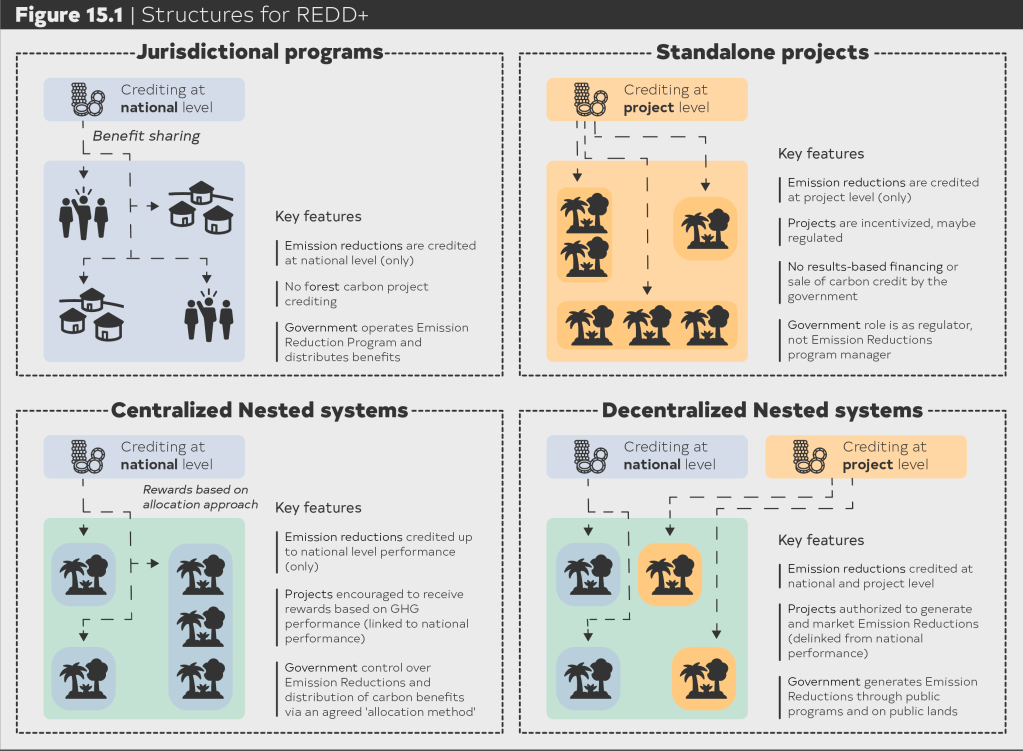Click a button to download a PDF version of Chapter 15
or scroll down to read online.
Countries may want to integrate Reducing Emissions from Deforestation and Degradation Plus (REDD+) activities across different scales to support jurisdictional programs and voluntary carbon market (VCM) projects. Nesting enables countries to support REDD+ at different investment and governance levels.
What is nesting?
Nesting refers to aligning the accounting of greenhouse gas (GHG) emission reductions and removals across scales. Nested REDD+ systems align accounting and reporting of greenhouse gas (GHG) emission reductions and removals from Avoided Deforestation (AD) projects and jurisdictional REDD+ programs. By integrating the accounting frameworks for different types of REDD+, nesting harmonizes the climate benefits of land-use activities implemented at different scales, helps to manage leakage, and enforces environmental safeguards.
Nesting enables REDD+ implementation at different scales by creating incentives for both public and private actors. Governments are best equipped to establish long-term sustainable land use systems, fight illegal activities and corruption, and grant secure land rights for Indigenous Peoples and local communities (IPs and LCs). Activity developers and local partners can design and implement solutions and establish benefit sharing arrangements for specific socio-ecological contexts. Companies can provide the investments and quickly disburse payments to accelerate climate change mitigation, while complying with regulations that push them to reduce emissions and deforestation in their supply chains.
Nested systems are likely to play a role in the design and implementation of REDD+ going forward. Effective nesting systems that generate high-quality carbon credits will attract private finance for forest conservation and climate change mitigation interventions. The ideal nesting arrangement aligns privately funded projects with jurisdictional REDD+ programs to protect forests at scale while maximizing cooperation between private and public actors.
| Box 15.1: Is nesting required for REDD+ to generate credits that are traded in the VCM? REDD+ projects may be developed and generate tradable units without being nested if a country does not have a nesting approach. REDD+ can function as a jurisdictional program in which all activities are managed by the government, with no separate accounting or crediting, and payments are made through benefit sharing arrangements. However, nesting is a good strategy to ensure alignment between national forest policies and project-level activities to reduce deforestation. Nesting can be implemented in a stepwise approach, starting with the coordination of jurisdictional reference level and project baselines, and moving to a more comprehensive nesting system over time. |
Why would governments engage in nesting?
Governments choose to engage in nesting because they want to recognize existing and future REDD+ project activities and implement REDD+ in accordance with local systems of land ownership and rights. In areas where several REDD+ projects already exist or where the right to the land implies the right to harvest its resources (including carbon credits), nesting projects in national systems is often the only way to implement REDD+. Nesting can help countries to meet results-based payment (RBP) goals under international or multilateral agreements, access finance for climate and forests goals, strengthen national REDD+ strategies, and generate jurisdictional-level carbon credits to sell in the VCM.
Nesting can incentivize direct private investment into REDD+ while increasing the integrity of REDD+ projects through conservative baselines and accounting of leakage across an entire jurisdiction. Credits from nested REDD+ programs may be more attractive to VCM buyers than credits from REDD+ projects because quality concernsassociated with inflated project baselines, leakage, permanence, and safeguards are thought to be better addressed through larger-scale programs, while investments are allowed to flow to distinct project activities. However, the quality of creditsfrom nested REDD+ programs depends on the integrity of national accounting methods and the ability to enforce regulation. The credibility of REDD+ programs depends on conservative forest reference (emissions) levels (FRELs), robust measurement, reporting and verification, and enforceable safeguards across all implementation levels.
Verra’s Verified Carbon Standard (VCS) is consolidating all REDD+ methodologies and other methodologies for certifying activities that avoid unplanned deforestation. This consolidation integrates REDD+ project baselines into historic national or jurisdictional FRELs. Ideally, these FRELs are developed or endorsed by national governments. However, they can also be created by the VCS itself. The consolidated VCS methodology revision addresses the risks of activity developers setting inflated baseline-setting and provides essential tools for nested REDD+.
How should nesting be designed?
Governments should identify clear policy objectives before designing a nested system. Local circumstances and policy preferences will determine how a country nests REDD+. Governments may also seek to access carbon finance through jurisdictional REDD+ or by providing high-integrity frameworks for private REDD+ investments that are not part of nested systems. In areas where all rights to land and future carbon credits rest with the state, the government may implement nested REDD+ in the context of a government-administered benefit sharing system.
Nested REDD+ can have varying degrees of government control. In centralized nesting systems, carbon credits are only issued at the national scale and projects participate in REDD+ through government-controlled benefit sharing (for example, through payment for ecosystem services programs). In decentralized nesting systems, credits are generated at the project scale, and projects generate and market credits independently from the government. In countries where VCM REDD+ projects are under implementation, or are generally welcome, decentralized nesting is often favored because it more easily integrates existing agreements and avoids legal controversy with participants in existing projects. Figure 15.1 shows how REDD+ can be structured as jurisdictional programs or stand-alone projects in a country with no nesting systems, or under centralized or decentralized nesting systems.

The two jurisdictional REDD+ standards —Verra’s Jurisdictional and Nested REDD+ Framework (JNR) and the Architecture for REDD+ Transactions’ The REDD+ Environmental Excellence Standard (ART/TREES) — define criteria for nested REDD+. In both cases, governments have the choice between centralized or decentralized nested systems. While JNR offers detailed guidelines rules for nested REDD+, ART/TREES defines nesting scenarios but leaves the details for the participating governments to decide.
What are the key features of nested REDD+ systems?
Nested REDD+ systems require that governments have credible REDD+ carbon accounting systems in place. To promote alignment in baseline setting across REDD+ activities, governments can mandate conformity in baseline and monitoring methodologies, allocate FRELs to ensure that project baselines do not exceed jurisdictional baselines, or set maximum crediting levels for projects. Governments must also decide on the REDD+ activities that will be included in nesting, and establish definitions, data, and methods for estimating GHG emissions. For effective nested REDD+, governments must have the ability to track and register projects and credits, ensure consistency of data, and share this information transparently. Governments should also consider whether and when they will back REDD+ transactions with corresponding adjustments under Paris Agreement Article 6.
Government institutions should have clearly assigned responsibilities for the implementation of nesting. Institutional infrastructure is needed to manage the technical, financial, administrative, and supervisory aspects of nesting, and for the allocation of GHG emission reductions, management of funds and sharing of associated benefits. Government institutions are responsible for monitoring, verifying, and accounting for jurisdictional emission reductions. Governments should consider creating registries, national monitoring systems, and other data management mechanisms to facilitate effective nesting implementation and institutional coordination.
Clear land and carbon rights also inform the design of nested REDD+ systems. Clarifying land tenure and associated carbon rights through laws or contracts facilitates the implementation of REDD+ nesting. Governments should consider legal rights of existing avoided deforestation projects and how these rights need to be integrated into nested REDD+ systems. Depending on the land systems and rights of communities and individuals, governments may have to take into account future REDD+ projects and create measures for those projects to be legally nested in jurisdictional systems. Governments should also establish benefit sharing plans that detail how carbon finance from REDD+ is distributed, and the monetary or non-monetary incentives that will be shared.
Governments can implement safeguards for nested REDD+ activities. Participatory consultations with local actors are essential to successful integration of existing REDD+ projects with nested systems. Nested REDD+ should align with the objectives of national forest programs and international agreements; be transparent and account for national legislation and sovereignty; respect the knowledge and rights of IPs&LCs; ensure the full and effective participation of relevant stakeholders; promote conservation of forests and biodiversity; address the risks of reversals; and avoid displacement of emissions. In addition to safeguards imposed by governments, private project developers or carbon standards may impose safeguard requirements.
Governments should also consider the risks inherent to nested systems, particularly the underperformance of jurisdictional programs or projects in generating GHG emission reductions and removals. Corporate buyers may prefer to trade credits directly with project developers or invest directly in REDD+ projects because they are not able or willing to assume the risk of government implementation failure. However, governments can increase corporate support for jurisdictional programs by establishing clear nesting rules and by defining rules that allocate the risk of non-performance at the project or jurisdictional levels. Methods to reduce risks depend on the type of nested REDD+ system, and may include: strengthening institutions and governance to provide effective implementation; sharing of performance risks; establishing accountability mechanisms; securing multiple streams of finance; compensating actors negatively impacted by nesting (e.g. where rights to carbon are centralized and need to be compensated), including relevant stakeholders in REDD+ and benefit sharing designs; and using the most updated methodologies for calculating GHG emission reductions and removals.
Further Reading
- Hamrick, K., Webb, C., & Ellis, R. (2021). Nesting REDD+: Pathways to Bridge Project and Jurisdictional Programs. Retrieved August 9, 2021, from https://www.nature.org/content/dam/tnc/nature/en/documents/REDDPlus_PathwaystoBridgeProjectandJurisdictionalPrograms.pdf
- Streck, C., Lee, D., Cano, J., Fernandez, M., Llopis, P., Landholm, D., et al. (2021). Nesting of REDD+ Initiatives: Manual for Policymakers ( No. AUS0002247) (No. AUS0002247). Retrieved October 11, 2021, from https://documents1.worldbank.org/curated/en/411571631769095604/pdf/Nesting-of-REDD-Initiatives-Manual-for-Policymakers.pdf
Acknowledgements
Authors: Melaina Dyck, Charlotte Streck, and Danick Trouwloon
Designer: Sara Cottle
Contributors: Leo Mongendre, Pablo Nuñez, María José Rodezno, Laura Carolina Sepúlveda, and Theda Vetter
Date of publication: October 2023
The Voluntary Carbon Market Explained (VCM Primer) is supported by the Climate and Land Use Alliance (CLUA). The authors thank the reviewers and partners that generously contributed knowledge and expertise to this Primer.
